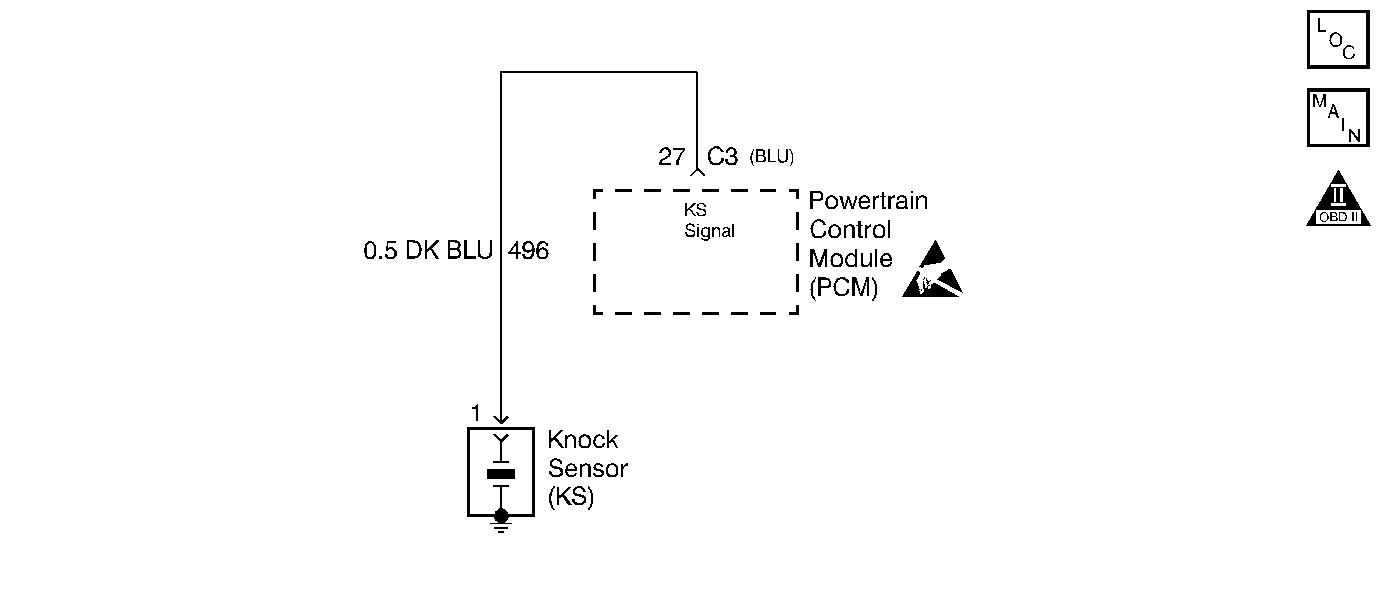
Circuit Description
The knock sensor (KS) system is used to detect engine detonation. The knock sensor produces an AC voltage signal. The knock sensor sends this signal to the KS module. The amplitude and the frequency of the AC voltage signal depends upon the knock level being detected. The PCM will then retard the spark timing based on the signals from the KS module.
Conditions For Setting The DTC
| • | The KS voltage is less than 0.19 V or greater than 4.99 V. |
| • | The engine speed is between 2200 RPM and 6375 RPM. |
| • | The TP angle is greater than 5 %. |
| • | One or more of the following DTCs are not set P0117, P0118, P0122, P0123. |
OR
| • | The knock is present for greater than 2.3 seconds over a 6 second interval. |
| • | One or both of the following DTCs are not set P0122, P0123. |
Action Taken When the DTC Sets
| • | The Malfunction Indicator Lamp (MIL) will illuminate. |
| • | The PCM will record operating conditions at the time the diagnostic fails. The Freeze Frame and Failure Records buffers will store this information. |
| • | A history DTC is stored |
| • | The PCM will fault to base timing. |
Conditions for Clearing the MIL/DTC
| • | The malfunction indicator lamp (MIL) will turn OFF after 3 consecutive ignition cycles in which the diagnostic runs without a fault. |
| • | A history DTC will clear after 40 consecutive warm up cycles without a fault. |
| • | Use a scan tool to clear the DTCs. |
Diagnostic Aids
Correct any abnormal engine noise before using the diagnostic table.
Check for an open ignition feed circuit.
Test Description
The numbers below refer to the step numbers on the diagnostic table.
-
The Powertrain OBD System Check prompts the technician to complete some basic checks and store the Freeze Frame Data and the Failure Records on the scan tool if applicable. This creates an electronic copy of the data taken when the fault occurs. Refer to this information on the scan tool later.
-
Whenever the conditions for the test as described above are met, a DTC P0325 will set and the MIL will illuminate.
-
The scan tool displays knock sensor activity in counts, approximately 35-50 at idle. The counts should increase when the engine speed increases. The counts should decrease as the engine speed decreases.
-
Checking the internal resistance of the knock sensor verifies if the knock sensor is operating properly.
-
Before replacing the PCM, check the terminals for improper mating, broken locks, or physical damage to the wiring harness. Reprogram the replacement PCM. Refer to the latest Techline information for programming procedures.
Step | Action | Value(s) | Yes | No |
|---|---|---|---|---|
Was the Powertrain On-Board Diagnostic (OBD) System Check performed? | -- | |||
Does the Malfunction Indicator Lamp (MIL) illuminate? | 10 % | |||
3 |
Does the Malfunction Indicator Lamp (MIL) illuminate? | -- | ||
4 | Listen to the engine while raising and lowering the engine speed. Is a knock or audible noise present? | -- | ||
5 | Repair the engine mechanical problem. Is the action complete? | -- | ||
Slowly increase the engine speed to the specified value. Does the KS Activity increase with the engine speed? | 2500 RPM | |||
7 | Check for a poor connection at the PCM connector knock sensor signal circuit and repair if necessary. Refer to Wiring Repairs in Engine Electrical. Was a repair necessary? | -- | ||
8 | Was the KS module previously replaced? | -- | ||
Replace the PCM. Refer to Powertrain Control Module Replacement/Programming . Is the action complete? | -- | -- | ||
10 | Replace the Knock Sensor (KS). Refer to Knock Sensor Replacement . Is the action complete? | -- | -- | |
Is the measured value within the specified value? | 90,000 to 110,000 ohms | |||
12 | Check the knock sensor electrical connector for a poor connection and repair as necessary. Refer to Wiring Repairs in Engine Electrical. Was a repair necessary? | -- | ||
13 |
Was a repair necessary? | -- | ||
14 | Replace the KS module. Refer to Knock Sensor Module Replacement . Is the action complete? | -- | -- | |
15 |
Does the scan tool indicate that this diagnostic ran and passed? | 90°-95° C | ||
16 | Check if any additional DTCs are set. Are any DTCs displayed that have not been diagnosed? | -- | Go to the Applicable DTC Table | System OK |
